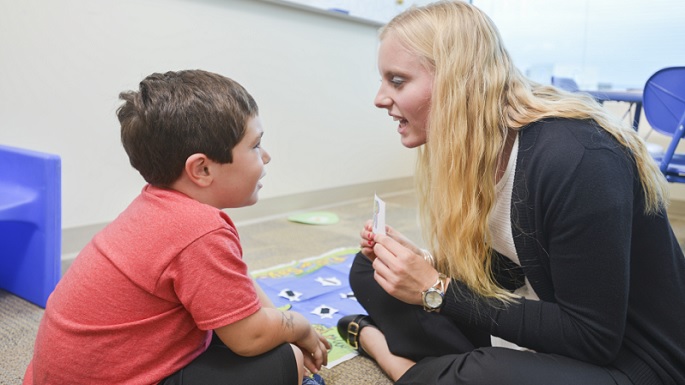Speech Therapy For Autism
Are you interested in learning about speech language therapy for autism? If so, you’ve come to the right place! In this article, we’ll dive into the fascinating world of speech therapy and how it can make a positive impact on individuals with autism.
Speech language therapy is a specialized approach that focuses on helping individuals with autism improve their communication skills. Through a variety of techniques and exercises, speech therapists work to enhance language development, articulation, and social communication abilities.
So, why is speech language therapy so important for individuals with autism? Well, communication plays a vital role in our everyday lives, allowing us to express ourselves, connect with others, and participate in various social situations. For those with autism, who may experience challenges in these areas, speech therapy can be transformative, empowering them to effectively communicate and engage with the world around them.
Now that you have an overview of what speech language therapy for autism entails, let’s delve deeper into the various strategies and interventions that are used to support individuals on their communication journey.

Speech Language Therapy for Autism: Unlocking Communication Skills
Welcome to an in-depth exploration of speech language therapy for autism. Autism is a neurodevelopmental disorder that affects communication and social interaction. Individuals with autism often face challenges in expressing themselves verbally and understanding the nuances of language. Speech language therapy is a crucial intervention that can help individuals with autism develop their communication skills, enhance their social interactions, and improve their overall quality of life. In this article, we will delve into the details of speech language therapy for autism, its benefits, techniques, and tips for effective implementation.
Understanding Autism and Communication
Autism is a complex spectrum disorder that affects individuals differently. However, many people with autism share difficulties in communication. Communication encompasses both receptive language (understanding spoken words and instructions) and expressive language (the ability to use language to express thoughts, needs, and emotions). For individuals with autism, these communication challenges can manifest in various ways.
Some individuals may struggle with verbal communication and have limited speech or difficulty forming meaningful sentences. Others may have strong verbal skills but struggle with social communication and understanding social cues. Nonverbal individuals may rely on alternative forms of communication, such as sign language or assistive technology. It is essential to recognize that each person with autism is unique and may require an individualized approach to speech language therapy.
The Role of Speech Language Therapy
Speech language therapy plays a vital role in supporting individuals with autism in their communication journey. The primary goal of speech language therapy is to help individuals develop functional communication skills, facilitate social interactions, and improve overall language comprehension.
A qualified speech-language pathologist (SLP) will assess the individual’s specific communication challenges and tailor therapy sessions accordingly. These sessions can include a variety of techniques and strategies, depending on the individual’s needs. Speech language therapy can address areas such as:
- Articulation and Speech Clarity: Improving the production of speech sounds, clarity, and intelligibility.
- Expressive Language: Helping individuals develop vocabulary, sentence formation, and coherent expression of thoughts and ideas.
- Receptive Language: Enhancing understanding of spoken language, following instructions, and comprehension of questions and conversations.
- Social Communication: Teaching individuals the rules of conversation, understanding and expressing emotions, and interpreting non-verbal cues.
- Alternative and Augmentative Communication (AAC): Introducing alternative modes of communication, such as gestures, signs, picture communication systems, or assistive devices.
By targeting these areas, speech language therapy aims to bridge the communication gap and provide individuals with autism the necessary skills to navigate their daily lives effectively. It is important to note that speech language therapy is just one piece of the autism intervention puzzle, and a multidisciplinary approach involving other therapies and supports is often necessary for comprehensive development.
Effective Techniques and Strategies in Speech Language Therapy for Autism
Now that we understand the importance of speech language therapy for individuals with autism let us explore some effective techniques and strategies commonly used in therapy sessions:
Visual Supports and Visual Schedules
Individuals with autism often benefit from visual aids to support their understanding and communication. Visual supports such as picture cards, visual schedules, and social stories can help individuals with autism anticipate activities, understand routines, and express their needs and preferences. These visual supports provide a concrete representation of language, making it more accessible and meaningful to individuals with autism.
Structured Play and Social Skills Training
Play is an essential aspect of speech language therapy for individuals with autism. Through structured play activities, individuals can practice their social skills, verbal and nonverbal communication, and problem-solving abilities. SLPs often incorporate play-based interventions to create a fun and engaging learning environment that promotes communication success.
Augmentative and Alternative Communication (AAC)
For individuals who struggle with verbal communication or are nonverbal, augmentative and alternative communication systems can provide an invaluable means of expression. AAC encompasses various methods, including sign language, picture exchange communication systems, and speech-generating devices. SLPs work closely with individuals and their families to determine the most suitable AAC methods and provide training to ensure successful implementation.
Parent and Caregiver Involvement
Speech language therapy is most effective when there is collaboration between the SLP, the individual with autism, and their family or caregivers. Parents and caregivers play a vital role in reinforcing therapy goals and strategies in the individual’s everyday life. SLPs often provide education and training to parents and caregivers, empowering them to support and facilitate their child’s communication development outside of therapy sessions.
The Benefits of Speech Language Therapy for Autism
The benefits of speech language therapy for individuals with autism are far-reaching. Effective communication skills not only enhance social interactions but also facilitate meaningful relationships and opportunities in various aspects of life. Here are some key benefits of speech language therapy for individuals with autism:
- Improved expressive and receptive language skills
- Enhanced social communication and interaction
- Increased vocabulary and sentence formation
- Greater clarity and intelligibility of speech
- Improved understanding and use of non-verbal communication cues
- Reduced frustration and anxiety related to communication challenges
Ultimately, speech language therapy aims to provide individuals with autism the tools they need to communicate effectively, express themselves, and participate fully in their communities.
Supporting the Journey to Communication Success
Speech language therapy is an integral part of the intervention plan for individuals with autism. However, it is important to remember that communication development is a gradual process and may vary for each individual. Patience, consistent practice, and a supportive environment are key to facilitating growth and progress in communication skills.
As a parent, caregiver, or educator, it is essential to work collaboratively with speech-language pathologists and other professionals to ensure a holistic approach to supporting individuals with autism. Celebrate every milestone and small achievement along the way and provide opportunities for communication in various contexts.
Remember, speech language therapy for autism is not a one-size-fits-all approach. It is tailored to meet the unique needs of each individual. By harnessing the power of speech language therapy and providing the necessary support and understanding, we can help individuals with autism unlock their communication potential and thrive in their journey of self-expression and connection.
Key Takeaways – Speech Language Therapy for Autism
- Speech language therapy can help children with autism improve their communication skills.
- Therapists use various techniques to target specific speech and language difficulties.
- Visual supports, such as pictures and gestures, can aid in understanding and expressing language.
- Speech-language therapy sessions are tailored to the individual needs of each child with autism.
- Regular and consistent therapy sessions can lead to significant improvements in communication abilities.
Frequently Asked Questions
Welcome to our Frequently Asked Questions section on speech language therapy for autism. We understand that you may have some questions about this topic, so we’re here to provide answers. Read on to find out more!
1. How does speech language therapy benefit individuals with autism?
Speech language therapy plays a crucial role in helping individuals with autism improve their communication skills. It focuses on addressing the specific challenges they may face, such as difficulties with language development, understanding non-verbal cues, or using appropriate social language. The therapy sessions are tailored to the individual’s needs, targeting areas like vocabulary, grammar, articulation, and pragmatic language skills.
Therapists use various techniques, including visual supports, social stories, and interactive activities, to engage individuals with autism in meaningful communication. Speech language therapy helps individuals with autism express their thoughts and feelings more effectively, increase their social interactions, and enhance their overall quality of life.
2. When should a child with autism start speech language therapy?
The earlier a child with autism starts speech language therapy, the better. Ideally, speech therapy can begin as soon as the child receives an autism diagnosis. Early intervention provides the best opportunity for the child to develop essential communication skills that will support them throughout their lives.
However, even if a child with autism is diagnosed later in life, speech language therapy can still be beneficial. It is never too late to start therapy and work on enhancing communication abilities. The therapy approach may differ depending on the child’s age and needs, but the overall goal remains the same: to improve their communication skills and support their development in this area.
3. How long does speech language therapy for autism typically last?
The duration of speech language therapy for autism can vary depending on the individual’s needs and progress. There is no definitive timeline as each person’s therapy journey is unique. Some individuals may require therapy for a few months, while others may continue for several years.
The therapy sessions are typically scheduled on a regular basis, ranging from once a week to multiple times a week, depending on the severity of the communication challenges. The therapist continuously assesses the individual’s progress and adjusts the therapy plan accordingly to ensure optimal outcomes.
4. Can speech language therapy be done at home?
Yes, speech language therapy for autism can be done at home, in addition to sessions conducted by a licensed therapist. Parent involvement is crucial for the success of therapy, and therapists often provide strategies and activities for parents to practice at home.
Home-based therapy activities might include practicing specific speech exercises, using visual supports and communication aids, engaging in interactive play to promote language development, and incorporating language-building activities into daily routines. Consistency and support from parents or caregivers at home can reinforce the progress made during therapy sessions.
5. Are there any alternative approaches to speech language therapy for individuals with autism?
While speech language therapy is the most widely recognized and evidence-based approach for addressing communication challenges in individuals with autism, there are alternative approaches that can complement traditional therapy. These may include sign language, augmentative and alternative communication (AAC) devices, and other alternative communication systems.
These alternative approaches can be used alongside speech language therapy or as the primary means of communication for individuals who are non-verbal or have limited speech. The decision to incorporate alternative approaches should be made collaboratively between the individual, their family, and their speech language therapist, based on the individual’s unique needs and preferences.
Summary
Speech-language therapy can greatly help children with autism improve their communication skills. Therapists use various techniques to work on areas such as speaking, understanding language, and social interaction. This therapy is individualized to meet each child’s specific needs and can make a significant difference in their daily lives.
With speech-language therapy, children with autism can learn to express themselves better, understand others more easily, and engage in meaningful conversations. The therapy sessions focus on building vocabulary, practicing speech sounds, and developing social skills like turn-taking and maintaining eye contact. Through consistent and targeted therapy, children with autism can make progress and achieve their communication goals, leading to increased independence and improved quality of life. It is essential for families to work closely with speech-language therapists to provide ongoing support and reinforcement of skills learned in therapy.


